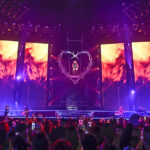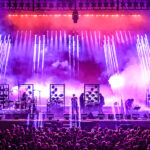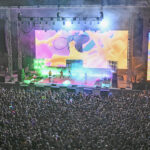Eric Cathcart says that, in terms of a career, he really hasn’t done anything but lighting. In high school, he was involved in the theatre tech departments, then was a technical theatre major in college when he picked up a gig with a local production company. From there, he worked in the San Francisco Bay Area with Morpheus Lights and a few other California lighting companies. He move on to Midnight Lighting in Austin, TX as an LD and tech and did his first tour for Asleep at the Wheel. From there, it was on to Nashville, working for Bandit Lites (Def Leppard, Brooks & Dunn, Reba McEntire and many others). In 1995, he was given the opportunity to be the designer for Olivia Newton-John. From there, the design/director gigs started trickling in. He’s also working as LD under Dan Hadley on tours. Prior to The Black Keys he’s designed Michael Bolton, Thievery Corporation, LCD Soundsystem and The Darkness. The last couple of years he’s been doing CAD drawings for Premier Global Production, including designs for some sizeable festivals.
Lighting designer and director Michael Grant, who’s been working at House of Blues Chicago for about 11 years, has also worked with Plain White T’s, The Replacements and Johalla Projects, an art gallery in Chicago that does a lot of work around the city.
ERIC CATHCART
Co-Designer, Video Director and Set Designer
Having a lighting background has been a huge advantage, says co-designer, video director and set designer Eric Cathcart.
“From the beginning, we knew that we needed to have I-Mag at the level of shows that we would be playing, but neither of us are fans of people staring at the screens the entire show rather than looking at the stage. In order to create our ’anti-I-Mag’ I-Mag show, we have distorted nearly all camera shots, and I black out the screens on a regular basis to keep the attention on the stage. I think that not being afraid to black out the screens is certainly a product of my lighting background. There are also moments in the show where I am using the screen sections as solid blocks of color that match or contrast with what is going on with the lighting rig.”

Once Cathcart added the video element to the design, he and Michael Grant knew that it had to move.
“I’ve had the idea for several small screens rattling around in my head for a while. When Michael and I were sitting down to design the show, I told him what I was thinking, and he showed me a picture of The Rolling Stones’ Now album cover, which has pictures of the different band members in different sizes randomly scattered across the cover. He explained that Dan [Auerbach — vocals & guitar] once mentioned that he would like to see something like that on the stage. Logistically, it just all came together. I had put the screens in as random sizes in random places for the renderings, and the real life screens ended up being almost spot to the renderings. Since we have been working with Show Distribution out of Quebec, the automation of both the screens and trusses has truly come to life.”
Cathcart is using VER as the tour video vendor, with Graham Buttrey as their rep.
“Everything has been so smooth that I haven’t had much contact with him since the show prepped for rehearsals back in May. Up until this point, I had only used VER as a rental house for a few items here and there. Patrick Eaton was the technical wizard in the pre-production phase and did an amazing job of taking my lighting guy vision of what I wanted the video to do and translating that into what video guys actually need to do to make it all work.”

In the end, Cathcart says, this project has been a “mixed bag of nuts.”
“Originally, there wasn’t going to be any content, just cameras with effects. Michael Carney, who has done all of the album art work and is essentially the band’s artistic director, wanted to use the psychedelic brain teaser and optical illusion aesthetics of the current album artwork throughout the show. Michael had some people that he knew create some of the distortion content that is layered on top of the camera shots. Our tour manager, Jim Runge, brought in Simon Edwards of Visual Artforms to create some original animations for us. I think that we have about 200 plus clips from him. There are only a handful of songs that we ended up using these animations. Every now and again, I will revisit the catalog of content that we have for those songs and change it up a bit. I also created a few of the animations and shot all of the video content that ended up in the show. Another element to the show is that I have Ryan Kerchner directing the cameras and sending a program feed to me as well. This gives me a total of nine video inputs to choose from.”
Cathcart is running the video using the grandMA2 Light.
“I’ve been using the MA platform for the last five or so years. I am very well aware that I am barely scratching the surface of the versatility of the console. It seems that every time I am around another MA programmer, I learn a new thing about the desk. Programming video was a bit of a transition for me. I chose to use Catalyst due to the number of different mix windows available. With 17 individual screens and wanting to be able to have a single image across different configurations of multiple screens, I think that Catalyst now having 40 mix windows might be the only option to do so. The Catalyst that I am using is a custom machine that I built that is running the new style Mac Pro. It has amazing speed and handles all of the camera inputs with zero processing lag. The rack was built specifically for multiple camera inputs and includes on board pre-catalyst preview monitors.

“The lighting floor package — the carts that Gallagher built — have been super versatile. They allow us to have only 13 fixtures that ride in cases and need only to be packed up and pulled out everyday. Three of those were added after the tour was underway. All other fixtures in the show live in custom carts or in truss to facilitate a quick load-in and load-out. This whole design process has truly been a collaboration between Michael and I — we truly share a similar aesthetic that we both brought to this project.”
MICHAEL GRANT
Co-Designer, Lighting Designer & Director
Michael Grant first started with The Black Keys in 2008 as lighting director at the beginning of the Attack & Release tour. For this run, Grant is co-designer, lighting designer and director. He explains he was looking for something that added a backdrop to the band — elements that would more enhance the performance, rather draw your attention away from it.
“I wanted to have the ability to transform the stage from intimate to arena. I believe Eric (Cathcart) and I have worked it out so there’s a big show happening, but the main focal point is the four guys on stage. During programing of the tour, it was all pretty seamless. For each song, we would figure out what colors we had in mind, then popped on headphones and just banged it out. After, we would do a run though together, swap ideas on changes and move on. But even now we continue to change things and bounce things off each other, which really helps the show grow and improve.”

When Grant and Cathcart offered up the design, the band had some minor changes/additions, but the designers were otherwise given the go-ahead.
“It’s been great letting us really take this on. I feel like we’ve all been working together long enough to know what each others take on a rock ‘n’ roll show is, along with each others expectations. Eric has been working in this business a long time, and I’ve been with the band for a number of years. So between that there is a trust. I feel the band trusts us to make the choices on when to bring the “big rock show” look and when to strip it down to its bones and keep it almost too simple. That’s another thing that I’ve noticed. We are making choices against our better judgment. There’s been a few times where we’ll have a big rock part and say “Every ounce in me thinks this part should be huge with a lot of hits and flash.” More often than not, we do the complete opposite, just turn the lights on, and watch the band play. This also goes along with expectations. This is by far the largest production the band has ever toured with. The band expects a show that is different, visually interesting, artistically appealing and, for lack of a better term, not annoying. As far as Eric and my own expectations, I think they are ever changing. As for myself, I’m very happy with the work we have done on this tour, but it can always be better. I’m rarely completely satisfied.”
For this tour, Grant’s been working with Alfred Larter and Christie Lites. He credits both the company and the crew, including crew chief Jaye Murphy, lighting tech Allyson Solar and dimmer tech Robert Behounek, as “absolutely stellar.” Grant details the fixtures for the tour.
 “In the air, we are working with [Martin] MAC Viper Air FX, MAC 2K washes, SGM X-5 strobes, 4-light Moles and [Clay Paky] Sharpy Washes, which I was very excited to use on this. We were using standard Sharpys on the last run, and they were fun, but the washes are way more functional to our show. [They are] very versatile compared to the spot model. First of all, the CMY makes them finally useable with other fixtures when it comes to cue transitions. And although they are considered to be ‘wash’ fixtures, the beams can get tight enough to use them as spot fixtures and let the Viper Air FX take the role of wash fixture. It really inspires you to explore the possibilities of both fixtures.
“In the air, we are working with [Martin] MAC Viper Air FX, MAC 2K washes, SGM X-5 strobes, 4-light Moles and [Clay Paky] Sharpy Washes, which I was very excited to use on this. We were using standard Sharpys on the last run, and they were fun, but the washes are way more functional to our show. [They are] very versatile compared to the spot model. First of all, the CMY makes them finally useable with other fixtures when it comes to cue transitions. And although they are considered to be ‘wash’ fixtures, the beams can get tight enough to use them as spot fixtures and let the Viper Air FX take the role of wash fixture. It really inspires you to explore the possibilities of both fixtures.
“This is not a “spot” heavy show. I think there is really only one song that uses a gobo, and even then, I’m still questioning that. The 12 upstage ‘floor’ Vipers shooting through the ‘forest’ and through the risers — which we chose not to skirt for this reason — give us all the texture we really need. For the ‘forest’ on the ground, we are using PAR 64 cans with Narrow lamps, a mixture of 1 and 2 light moles, SGM X-5 led strobes and Martin Auras. Even with all the bells and whistles of this show, it’s still the Black Keys. They are still a rock ‘n’ roll band, and I think PAR cans and 1- and 2-light Moles were the way to go to still give that rock ‘n’ roll look for when the real rippers come up. And I’ve also been a fan of white light a lot more this run, so I split up the PAR cans where it’s almost half and half no-color tungsten cans, and then some with LEE 201’s added. The white light the 201 adds makes the tungsten look a lot dirtier in comparison, which is the way I want to see a PAR can. And with the Auras, I can color-match them and almost double everything. It can be a very dynamic floor package.”
THE BLACK KEYS TURN BLUE TOUR 2014-15
PRODUCTION COMPANIES
Lighting: Christie Lites
Video: VER
Staging: Gallagher Staging (fabrication)
Staging: All Access (touring risers)
Kabuki/Austrian Drops: Sew What?
Trucking: Stage Call
Rigging: Show Distribution
Media Server: Bigtime Lighting Design LLC
CREW
Co-Designers: Eric Cathcart/Mike Grant (Bigtime Lighting Design LLC)
Lighting Director: Michael Grant
Video Director/Set Design: Eric Cathcart
Lighting Crew Chief: Jaye Murphy
Lighting Techs:
Allyson Solar, Robert Behounek
Camera Director/Video Crew Chief: Ryan Kerchner
Video Techs: Sixx Williams, Michael Boggs, David Vega
Tour Manager: Jim Runge
Production Manager: Anthony Pitcher
Stage Manager: Nic Close
Riggers: Jack Richard, Frederic Jacques, Sebastien Beaulieu
Set Carpenters: George Werner, Chris Glatfelter
GEAR
Lighting:
4 grandMA2 Light consoles (4096 ch, w/ 2 NPUs)
48 Martin MAC Viper AirFX fixtures
33 Martin MAC Auras
23 Martin MAC 2000 Wash XBs
40 Clay Paky Sharpy Wash fixtures
32 SGM X-5 white LED strobes
10 Color Force 12s
11 Color Force 72s
10 1 Lite Blinder Par 36
16 2 Lite Blinder Par 36
28 4 Lite Linear Blinders
88 Par 64 Stubby
5 DF 50 Hazers
4 Versa Fans
Video:
188 VER BR15 (15mm LED tiles)
4 VER M2 Processors
4 ProPower Socapex distros
8 TMB Custom Ethercon Snakes
1 Ross Carbonite Switcher
8 VCIMC-922D HD-SDI POV cameras
2 Sony HXC-100 Cameras
Rigging:
36 Show Distribution Tour Lift (500kg)
15 Show Distribution Tour Lift (1,000kg)
15 Show Distribution Dog Bone Load Cells
For more Black Keys Turn Blue tour photos, go to
http://www.prolightingspace.com/photo/albums/the-black-keys-2014-extras


